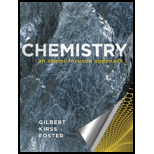
To find:
The number of hydrogen atoms in one molecule of (a) CH4; (b) C3H8; (c) C6H6; and (d) C6H12O6.
Answer to Problem 2.54QA
Solution:
(a) CH4: The number of hydrogen atoms is 4.
(b) C3H8: The number of hydrogen atoms is 8.
(c) C6H6: The number of hydrogen atoms is 6.
(d) C6H12O6: The number of hydrogen atoms is 12.
Explanation of Solution
1 mole = 6.022*1023 molecules.
a) CH4 – Here we can use Avogadro’s number as a conversion factor to calculate number of hydrogen atoms in 1 molecule of CH4.
1 molecule CH4 × (1 mole CH46.023×1023 molecule ×4 mole H1 mole CH4×6.023×1023H atoms 1 mole H)= 4 atoms of hydrogen
(b) C3H8 - Here we can use Avogadro’s number as a conversion factor to calculate number of hydrogen atoms in 1 molecule of C3H8.
1 molecule C3H8 × (1 mole C3H86.023×1023 molecule ×8 mole H1 mole C3H8×6.023×1023H atoms 1 mole H)= 8 atoms of hydrogen
(c) C6H6 - Here we can use Avogadro’s number as a conversion factor to calculate number of hydrogen atoms in 1 molecule of C6H6.
1 molecule C6H6 × (1 mole C6H66.023×1023 molecule ×6 mole H1 mole C6H6×6.023×1023H atoms 1 mole H)= 6 atoms of hydrogen
(d) C6H12O6 - Here we can use Avogadro’s number as a conversion factor to calculate number of hydrogen atoms in 1 molecule of C6H12O6.
1 molecule C6H12O6 × (1 mole C6H12O66.023×1023 molecule ×12 mole H1 mole C6H12O6×6.023×1023H atoms 1 mole H)= 12 atoms of hydrogen
Conclusion:
The number of hydrogen atoms can be calculated by using Avogadro’s number.
Want to see more full solutions like this?
Chapter 2 Solutions
Chemistry: An Atoms-Focused Approach
- 4) Which oxygen atom in the structure below is most basic / nucleophilic? Please explain by discussing the electron density around each oxygen atom. Show at least three resonance structures for the compound. оогоarrow_forwardCan you show me this problem. Turn them into lewis dot structures for me please and then answer the question because I cant seem to comprehend it/ The diagrams on the picture look too small I guess.arrow_forwardThe fire releases 2.80 x 107 Joules of heat energy for each liter of oil burned. The water starts out at 24.5 °C, raising the water's temperature up to 100 °C, and then raises the temperature of the resulting steam up to 325 °C. How many liters of water will be needed to absorb the heat from the fire in this way, for each 1.0 liter of crude oil burned? 4186 J/(kg°C) = heat of water 2020 J/(kg°C) = heat of steam 2,256,000 (i.e. 2.256 x 106) J/kg = latent heat of vaporization for water (at the boiling point of 100 °C).arrow_forward
- 6 Which of the following are likely to be significant resonance structures of a resonance hybrid? Draw another resonance structure for each of the compounds you select as being a resonance form. (A Br: Br: A B C D Earrow_forwardWrite the systematic (IUPAC) name for the following organic molecules. Note for advanced students: you do not need to include any E or Z prefixes in your names. Br structure Br Br Oweuarrow_forwardConservation of mass was discussed in the background. Describe how conservation of mass (actual, not theoretical) could be checked in the experiment performed.arrow_forward
- What impact would adding twice as much Na2CO3 than required for stoichiometric quantities have on the quantity of product produced? Initial results attachedarrow_forwardGiven that a theoretical yield for isolating Calcium Carbonate in this experiment would be 100%. From that information and based on the results you obtained in this experiment, describe your success in the recovery of calcium carbonate and suggest two possible sources of error that would have caused you to not obtain 100% yield. Results are attached form experimentarrow_forward5) Calculate the flux of oxygen between the ocean and the atmosphere(2 pts), given that: (from Box 5.1, pg. 88 of your text): Temp = 18°C Salinity = 35 ppt Density = 1025 kg/m3 Oxygen concentration measured in bulk water = 263.84 mmol/m3 Wind speed = 7.4 m/s Oxygen is observed to be about 10% initially supersaturated What is flux if the temperature is 10°C ? (2 pts) (Hint: use the same density in your calculations). Why do your calculated values make sense (or not) based on what you know about the relationship between gas solubility and temperature (1 pt)?arrow_forward
 ChemistryChemistryISBN:9781305957404Author:Steven S. Zumdahl, Susan A. Zumdahl, Donald J. DeCostePublisher:Cengage Learning
ChemistryChemistryISBN:9781305957404Author:Steven S. Zumdahl, Susan A. Zumdahl, Donald J. DeCostePublisher:Cengage Learning ChemistryChemistryISBN:9781259911156Author:Raymond Chang Dr., Jason Overby ProfessorPublisher:McGraw-Hill Education
ChemistryChemistryISBN:9781259911156Author:Raymond Chang Dr., Jason Overby ProfessorPublisher:McGraw-Hill Education Principles of Instrumental AnalysisChemistryISBN:9781305577213Author:Douglas A. Skoog, F. James Holler, Stanley R. CrouchPublisher:Cengage Learning
Principles of Instrumental AnalysisChemistryISBN:9781305577213Author:Douglas A. Skoog, F. James Holler, Stanley R. CrouchPublisher:Cengage Learning Organic ChemistryChemistryISBN:9780078021558Author:Janice Gorzynski Smith Dr.Publisher:McGraw-Hill Education
Organic ChemistryChemistryISBN:9780078021558Author:Janice Gorzynski Smith Dr.Publisher:McGraw-Hill Education Chemistry: Principles and ReactionsChemistryISBN:9781305079373Author:William L. Masterton, Cecile N. HurleyPublisher:Cengage Learning
Chemistry: Principles and ReactionsChemistryISBN:9781305079373Author:William L. Masterton, Cecile N. HurleyPublisher:Cengage Learning Elementary Principles of Chemical Processes, Bind...ChemistryISBN:9781118431221Author:Richard M. Felder, Ronald W. Rousseau, Lisa G. BullardPublisher:WILEY
Elementary Principles of Chemical Processes, Bind...ChemistryISBN:9781118431221Author:Richard M. Felder, Ronald W. Rousseau, Lisa G. BullardPublisher:WILEY





